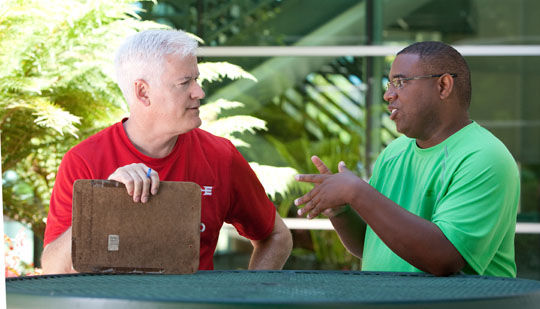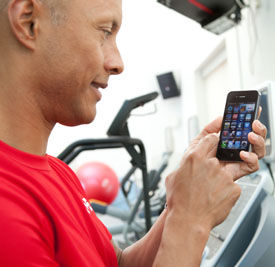
By Michael R. Mantell, Ph.D.
An estimated 51.4 million Americans belong to a health club and, according to IHRSA’s latest data, 12.5 percent use personal-training services. But what about the rest of America, especially the growing overweight and obese population? Two-thirds of U.S. adults are overweight or obese (Flegal et al., 2012), which means that 78 million adults, and more than 12 million children, are obese. This epidemic, costing the U.S. approximately $147 billion per year, feeds a $60 billion industry of products, services, diets and foods—all designed to help people lose weight. With the wave of diabetes, heart disease, orthopedic and other ailments linked to unhealthy weight, the American population is indeed in need of help.
Health coaches know how to help. But do you know how to reach those who aren’t among the 51.4 million who show up in gyms week after week?
To reach these seemingly unreachable clients, you need to possess savvy business-building know-how, passion-driven connectivity and well-honed skills and instincts, especially if your plan is to make a real living from the education and certification(s) you’ve worked so hard to obtain. After all, why shouldn’t you take a healthy slice out of that $60 billion pie?
What’s the Process?
If you are walking around your gym looking for overweight and obese clients, you may as well be on a treadmill. It’s a walk to nowhere. You have to think differently, create an entirely new mindset about finding clients (what I call “hunting and farming”) and execute your plan creatively.
Here’s an example of what I mean by thinking differently and working more creatively: Not too long ago, I began casting for a documentary I put together for ACE on how to build relationships with the obese and overweight population. I needed to locate the appropriate “cast” for my documentary, which meant going out and being where these folks might be. As it turned out, The Biggest Loser, the extreme weight-loss TV show, was holding a casting here in San Diego. I went to the casting and was able to recruit the guests I needed to appear in the documentary. In other words, I found a creative solution to identifying my targeted demographic.
Where are you hunting? The first step is a systematic identification of where your potential clients are hiding and residing. This is where you need to do your colliding.
No, I didn’t just walk up to overweight or obese folks in Starbucks and ask people if they wanted to be in a documentary to assist future professionals in the fitness industry learn how to work with that population. And, of course, you wouldn’t just go up to someone who is obese and ask if he or she wants help changing his or her lifestyle either. But you do need to know where and how to locate these potential clients.
Most gyms are not comfortable places for people who are significantly overweight and obese. The machines don’t fit, people often stare and the overall feeling may not exactly be welcoming. It’s enough to keep this population away from both group exercise and personal training in crowded health clubs.
Instead, consider this type of “hunting and farming:”
- Create a list of medical facilities (especially those that focus on weight loss), bariatric surgery centers, primary care and hospital-based programs, community health clinics and local YMCAs.
- Request an opportunity to meet and chat with the physician/clinic/facility about health coaching and/or fitness training for overweight and obese populations and how you can partner with them to assist their patients or clients.
- Consider approaching companies and offering your wellness services to them directly, or research already established corporate wellness programs. Corporate wellness programs typically consist of exercise, nutrition and healthy thinking offerings, and weight-related issues are frequently a driving force for participation.
- Offer free group presentations, workshops or no-cost, one-time consultations to community service organizations such as Kiwanis, Rotary, churches/synagogues, schools (both private and public) and Weight Watchers groups
 .
.
- Identify the websites, e-zines, magazines, newspapers, blogs, radio and TV programs, newsletters and common social media outlets that appeal to this specific population.
- Attend appropriate medical conventions in your area, contact the local medical society for those doctors that specialize in weight-related issues, and identify doctors that are connected with medical wellness, “exercise is medicine” and similar orientations through LinkedIn and other social-media networks. Offer to do a presentation at appropriate medical society functions, and join the appropriate LinkedIn and Facebook network groups.
- Create a brand for yourself as a weight-loss specialist.
- Be the local community “go to” expert for wedding and special-occasion weight loss (always emphasizing the continuing commitment to healthy living that is necessary even after the event).
- Offer free services for local races as the weight-management preparation expert.
- Do free “lunch-and-learn” workshops for companies on weight management.
- Create a food-log journal that includes information about you and your services and sell or give it away as an e-book.
- Pitch a weekly short segment on weight-loss to your local radio and TV stations, newspapers and magazines.
- Offer free “consultations” at local natural food stores and community health fairs.
Next step? Reach out to the people I call gatekeepers of the population you are trying to reach—physicians and professional health specialists, such as gastroenterologists, endocrinologists, internists, bariatric surgeons, cardiologists, orthopedists, chiropractors, nutritionists, psychologists and psychiatrists, social workers, acupuncturists, health coaches and life coaches. Take the time to communicate clearly in a professional and personally well-branded manner the types of services and value that you can offer their patients and clients.
What You Need to Know When Talking With Gatekeepers
A unique niche for health coaches and personal trainers is to work with the bariatric surgery centers in your local region. After all, according to a recent study done by the Miriam Hospital’s Weight Control and Diabetes Center, health coaches play a valued and important role in weight loss (Leahey and Wing, 2012).
Bariatric surgery centers are exceptional targets for collaborative work. Thinking in terms of “it takes a village” or what some call “affiliative marketing,” health coaches and personal trainers would be wise to connect with these facilities to make introductions and seek potential employment, particularly in the after-care group efforts. Contact the American Society for Metabolic and Bariatric Surgery at http://asmbs.org for more information on surgical centers of excellence in your region.
Tips for Communicating
Think of your initial written communication as an “elevator speech.” You often have less than a minute to make the “yes” impression. What can you say? Consider including some or all of the following:
- Your credential that makes you unique in working with the obese population
- Your understanding of the specific needs of this population
- The scope of your practice, being sure to emphasize your understanding of the roles the entire healthcare team plays
- The specific services you offer
- Always end with a call to action, a request to send material, meet, do a presentation, etc.
For example:
“Hi, my name is Paula Jones and I’m calling to introduce myself as someone in the community who is certified by the American Council on Exercise as a personal trainer/health coach…I’m interested in speaking with the doctor or an appropriate person in the office about my specialty working with weight-related health issues and obesity, particularly in terms of helping clients improve their health habits and fitness…Is there a good time for me to drop by and introduce myself and the ways in which I can be helpful to your patients?”
You could also practice giving your one-minute speech given in person. Always come across with confidence and end with a command to action:

“Hi, I would like to introduce myself. I am Paula Jones, and I am certified by the American Council on Exercise as a personal trainer/health coach. I specialize in working with weight-related health issues and obesity, especially in helping clients improve their overall lifestyle habits and start down the road of fitness. I would like to show you the ways I can help these particular clients and enhance the current services offered here. Perhaps we could schedule a meeting this week?"
Always remember to leave printed materials highlighting your background and services and send a thank-you note for the time. Small gifts, such as a Starbucks gift card, are appropriate as well.
Contact the appropriate individual by mail, email or phone call. After expressing your desire to work in concert with their healthcare team, offer to do a free presentation in a class or to the office staff about fitness and obesity. (Note: Avoid using the words “exercise” and “diet.”)
It’s important to follow up monthly with a report to the doctor/facility on the patients you are seeing. The more contact you have with your referrals, the more likely they will continue referring clients to you.
Use Contemporary, Social, Smart Marketing Strategies
David Carleton, a San Diego-based marketing specialist, believes that reaching out to potential obese and overweight clients “is the ‘lifeblood’ of the personal training and health coaching business.” However, he notes, “without a continuous stream of qualified prospects, many personal trainers and health coaches will never achieve the personal and financial success they desire.”
“To really succeed,” Carleton continues, “trainers and health coaches need to focus not just on the training aspect of their business, but on the marketing of their business too—not just doing, but marketing what they do.”
Marketing your services to the obese and overweight population directly can be daunting. According to Carleton, there are four proven methods, borrowed from other business models, which will help you speak directly with a potential client base. It’s time to ensure that you work on your business, not just in it.
Step 1 – Write a Free Special Report “e-Book”
Selling personal training and health coaching, especially to overweight and obese people, requires that your prospects be educated about who you are, what you do and how your training and coaching services can solve their problems. This type of education-based marketing is critical because the education process IS the selling process. Your clients want and need information and credible advice. A special report is an effective and inexpensive way to do just that.
A title such as Fitness Training and Sustainable Lifestyle Change – 7 Secrets to Picking the Right Personal Trainer and Health Coach is sure to attract attention and help you generate leads.
Step 2 – Add the Free Report to Your Website or Blog
Next, you want to offer your free report as an “opt-in” on your website. If you don’t have an attractive, informative, professional website, immediately hire someone to put it together for you. Creating an opt-in means offering your free report in exchange for their contact information. This is how you turn your website visitors into qualified leads. You can see an example of a special report and opt-in process here: http://LocalBusinessMarketingSuccess.com
Step 3 – Drive People to Your Website
- Create posts and tweets on Facebook and Twitter inviting friends, fans and followers to go to your website to download your free e-book.
- Do public speaking. Whenever you speak to an audience, you instantly become an expert and an authority in your field. Tip: The title of your speech can be the same as your special report.
- Publishing in local newspapers, magazines and online newsletters can provide you with a great venue to promote your special report. This can be in the form of a press release, article or blog.
Step 4 - Create Your Own Referral Network or Joint Venture Partners

A referral network is a group of businesses that offer complementary products and services to a group of people who share the same buying interests. To locate these businesses, consider who might already have a relationship with obese people? That’s where the physicians, surgery groups, local health clubs, schools and allied health-care professionals come in. Instead of competing against each other, the companies and people in your developing referral network band together to develop specific marketing activities and opportunities.
Summary
It is crucial you develop the skills, business instincts and contemporary know-how to find potential clients, gather them into your business and better understand what makes them tick. This is essential to developing long-term relationships with new clients and referral sources that you would otherwise not have, and selling these clients the services that best fit them over time.
References
Flegal, K.M. et al. (2012). Prevalence of obesity and trends in the distribution of body mass index among U.S. adults, 1999−2010. Journal of the American Medical Association, 307, 5, 491−497.
Leahey, T.M. and Wing, R.R. (2012). A randomized controlled pilot study testing three types of health coaches for obesity treatment. Obesity doi:10.1038/oby.2012.179
___________________________________________________________________
 Michael R. Mantell, Ph.D., earned his doctorate at the University of Pennsylvania after completing his M.S. degree in clinical psychology at Hahnemnann Medical College where he wrote his thesis on the psychological aspects of obesity. He coaches world-class athletes and fitness enthusiasts for mental and behavioral performance enhancement. He is Senior Fitness Consultant for Behavioral Sciences for ACE, Chief Behavioral Scientist for Anytime Fitness, on the faculty of the Equinox Fitness Training Institute, a national Community Ambassador for Experience Life Magazine's health initiative, appears weekly on San Diego's CW channel 6, is a consultant to Total Gym and Les Mills International, writes for IHRSA, and is a member of the Sports Medicine Team at the Sporting Club of San Diego specializing in fitness behavioral science. Dr. Mantell has written two best-selling books and provides opinion, commentary and analysis in print and broadcast media throughout the world.
Michael R. Mantell, Ph.D., earned his doctorate at the University of Pennsylvania after completing his M.S. degree in clinical psychology at Hahnemnann Medical College where he wrote his thesis on the psychological aspects of obesity. He coaches world-class athletes and fitness enthusiasts for mental and behavioral performance enhancement. He is Senior Fitness Consultant for Behavioral Sciences for ACE, Chief Behavioral Scientist for Anytime Fitness, on the faculty of the Equinox Fitness Training Institute, a national Community Ambassador for Experience Life Magazine's health initiative, appears weekly on San Diego's CW channel 6, is a consultant to Total Gym and Les Mills International, writes for IHRSA, and is a member of the Sports Medicine Team at the Sporting Club of San Diego specializing in fitness behavioral science. Dr. Mantell has written two best-selling books and provides opinion, commentary and analysis in print and broadcast media throughout the world.